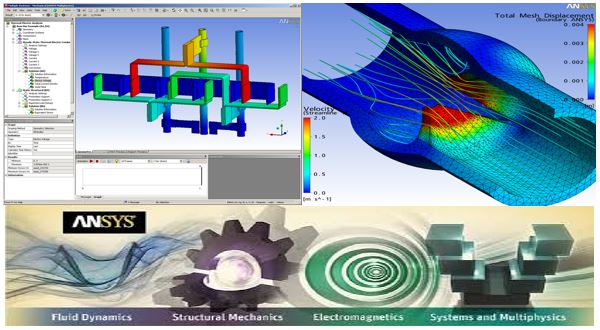1. ANSYS software
ANSYS is a comprehensive software that covers almost all fields of physics, helping to intervene in the world of virtual modeling and engineering analysis for the design stages. Most investors love this technical analysis software for what it does and how much it costs them.
This powerful analysis software takes the engineering design process to a new level, not only working with environments, variable parameters, and multi-level functions, but also supporting working adaptively with new engineering models, but feature-rich CAE tools. Of course, Ansys will help improve design efficiency, enhance creativity, reduce physical constraints and limitations, and perform simulation tests that cannot be performed on other software.
Ansys develops and markets finite element analysis software used to simulate engineering problems. This software creates computer models of structures, electronics or machine components to simulate stress, toughness, elasticity, temperature distribution, electromagnetics, fluid flow and other attributes. Ansys is used to simulate how a product performs with different specifications, without the need to prototype products or conduct crash tests. For example, Ansys software can simulate what a bridge will look like after many years of use, how to best handle salmon in a barrel to avoid waste, or how to design a skateboard that uses less material without losing safety.
Most simulations in Ansys are performed using Ansys Workbench software, which is one of the company’s main products. Typically, Ansys users break larger structures into small components that are simulated and tested individually. Users can start by defining the object’s dimensions, and then add weight, pressure, temperature, and other physical properties. Finally, Ansys software simulates and analyzes motion, fatigue, failure criteria, fluid flow, temperature distribution, electromagnetic efficiency and other effects over time.
Ansys also develops software for data management and backup, research and academic teaching. This software is sold on an annual subscription basis.
2. History of ANSYS software development
Phase 1: The first commercial version of Ansys software was labeled version 2.0 and released in 1971. At that time, the software was made up of punched card boxes and the program often ran overnight for results the next morning. In 1975, non-linear and thermoelectric features were added. This software was used exclusively on mainframes, until version 3.0 (second release) was introduced for VAXstation in 1979. Version 3 had a DOS-like command line interface.
Phase 2: In 1980, the Apple II was released, allowing Ansys to transition to a graphical user interface in version 4 later that year. Version 4 of the Ansys software is easier to use and adds additional features for electromagnetic simulation. In 1989, Ansys began working with Compuflo. Compuflo’s Flotran fluid dynamics software was integrated into Ansys under version 5, released in 1993. Performance improvements in version 5.1 shortened processing times by two to four times, and were followed by followed by a series of performance improvements to keep pace with advances in computing. Ansys also began integrating its software with CAD software, such as Autodesk.
Phase 3: In 1996, Ansys released DesignSpace structural analysis software, the LS-DYNA fall and release testing simulation product, and the Ansys fluid dynamics (CFD) simulator. Ansys also adds parallel processing support for PCs with multiple processors. The Ansys/ed educational product was introduced in 1998. Version 6.0 of the main Ansys product was released in December 2001. Version 6.0 made realistic large-scale modeling possible for the first time, but Many users were disappointed by the new blue UI. The interface was reworked a few months later in 6.1. Version 8.0 introduced the Ansys multidisciplinary solver, allowing users to simulate how many physics problems will interact with each other.
Phase 4: Version 8.0 was published in 2005 and introduced Ansys’ fluid-structure interaction software, which simulates the interaction between structures and fluids. Ansys also releases authentic design software products and DesignXplorer, both of which deal with probability and randomness of physical factors. In 2009, version 12 was released with the second version of Workbench. Ansys also began to increasingly consolidate features into its Workbench software.
Phase 5: Version 15 of Ansys was released in 2014. It added mowis functionality for composites, bolt connections and better meshing.
Phase 6: In February 2015, version 16 introduced the physical company AIM and Electronics Desktop. In 2016, version 17 introduced a new and improved user interface for computational fluid dynamics simulation. In January 2017, Ansys released version 18. Version 18 allows users to collect real-world data from products and then incorporate that data into future simulations. Ansys Application Builder, which allows engineers to build, use, and sell custom engineering tools, was also introduced with version 18.
Ansys is a quite popular CAE software today, used a lot by students and workers in study and research. It is a finite element analysis software completely used to simulate and calculate design. industrial design.
2.1. Modules on the software
2.1.1. Ansys Design Modeler and Ansys Meshing
Ansys Design Modeler and Ansys Meshing are the two introductory modules when we start to approach Ansys. These are two important modules that help us draw models and divide meshes right in ANSYS, serving the process of model calculation. simulation later. This course helps students understand the concept of modeling as well as take advantage of ANSYS’s “near-realistic” simulation capabilities, helping students gain proficient skills when drawing models. as well as meshing in ANSYS.


